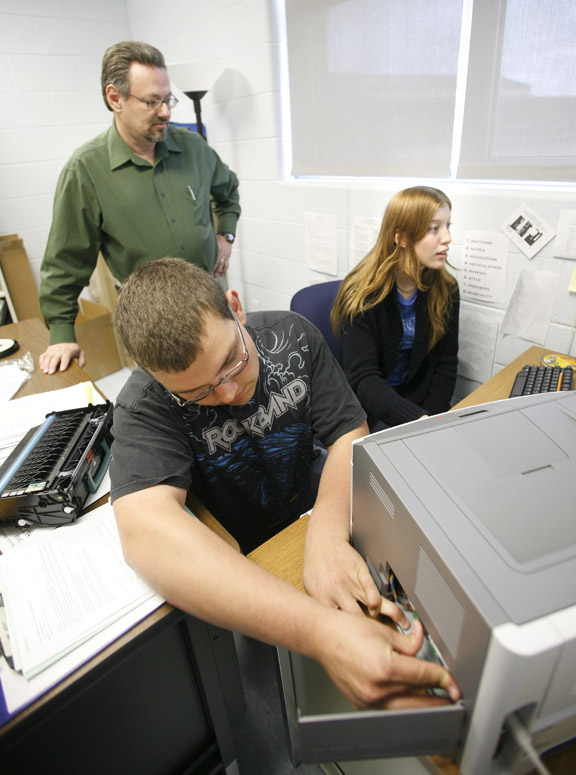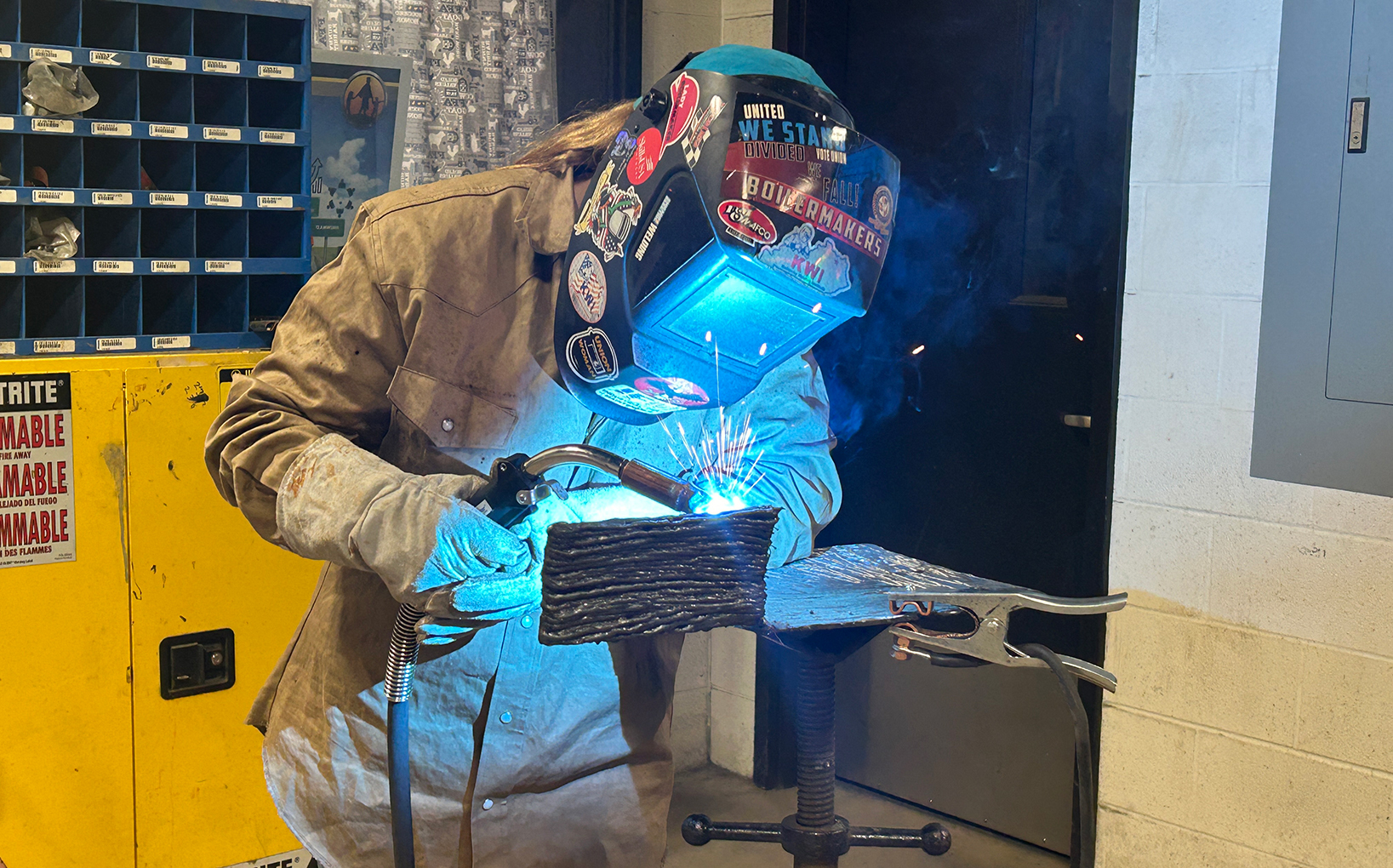
Mike Sexton, a teacher and technology coordinator at Montgomery County High School, supervises then-senior Sara Wood and then-junior Aaron Donathan as they fix a computer and printer for another teacher April 27, 2010. Districts are expanding their information technology programs to help students get skills necessary to succeed after high school. Photo by Amy Wallot
By Susan Riddell
Even 10 years ago, the phrase “less than a computer but more than a calculator” might have generated a collective shoulder shrug from students.
But that was then, and this is now. Educator Mike Sexton envisions such devices as learning tools in the years to come.
Sexton, a teacher and technology coordinator at Montgomery County High School, sees personal digital assistants (PDAs) and iPhones as potential teaching tools. Those, coupled with more room for labs and more teachers to fully staff an information technology (IT) program, will help students get the most out of a learning experience needed to succeed after high school.
“I would like to add programming,” said Sexton, a 27-year veteran in the classroom. “There is room to grow in Informatics (encompassing information science, information technology, algorithms and social science) as well. Without the latest tools and software, students will not be current and may lag behind.”
To keep students more current, many districts are pushing their IT programs to the limit, allowing students an enormous amount of freedom to pursue interests and stay current, as Sexton said.
The Harlan County school district has an abundance of class offerings for students. The courses are electives but necessary in rounding out the educational experience, according to Scott Pace, career and technical education instructor for Harlan County High School.
“These real-world experiences are what truly allow our students to make the connection between school and career and immediately see the value of what they are learning,” Pace said. “Many of our students are kinesthetic learners; learning takes place by the student actually carrying out a physical activity, rather than listening to a lecture or merely watching a demonstration. IT courses are electives and something that the students sign up for because they have a genuine interest in the subject area. They provide the students with an opportunity to gain hands-on experience, whether it is building a website, configuring a network router or delivering a broadcast message.”
For example, Harlan County High School offers courses in Web Page Design, Multimedia Publishing, Networking, Help Desk Computer Maintenance and Support.
Help desks run by students are becoming more common in high schools.
“We offer a Help Desk class that can be taken for up to four credits,” said Jody Johnson, a technology integration specialist at Walton-Verona High School (Walton-Verona Independent.) “Students work directly with the school technology assistant who oversees both the middle and high school technology resources. This includes managing our eight mobile lab units in terms of delivery, routine maintenance and assisting teachers who reserve them. Students also answer the phone and perform other tasks as necessary to address service requests submitted by staff members.”
Chad Parnell, technology coordinator at Adair County High School, has led a group of students on the help desk that reaches all five schools within the district.
“My help desk students are part of a districtwide student-operated technical support help desk,” Parnell said. “Two students are assigned to each school and visit that school once a week to complete work orders. When emergencies arise, they may go more often. The help desk students have proven to be an invaluable asset to our district support staff during computer lab installations, major software upgrades – basically any time they have needed more people than they can spare. The students learn the basics in the Computer Support Essentials class and then are ready to begin completing work orders and learning additional troubleshooting techniques in Help Desk.”
Sexton’s class at Montgomery County High is one of the more popular IT classes at the school. His students appreciate the experience they are gaining in the class, he said.
“Many students go on to work on college help desks,” Sexton said. “They have been very successful and several times have worked ahead of the recommended age level.”
The Help Desk class at Harlan County High also services the entire Harlan County district, and the Web design class reaches out to the community.
“Advanced Web Design students not only serve our community businesses, churches and non-profit organizations by providing professional-quality websites,” Pace said, “but they designed and maintain several of the websites for our local elementary schools as well.”
While students are reaping the benefits of burgeoning IT programs, teachers agree the programs must continue to grow and not become stagnant.
“Currently, students in our school wanting to pursue additional IT offerings enroll at one of the area technical centers for a portion of the school day,” Johnson said of the Walton-Verona students. “While this is a good opportunity for our students, it would be nice if there were more IT opportunities offered on campus. We were able to bring in a guest lecturer one year for a portion of the day who taught specific programming languages. It would be advantageous to do this on a regular basis.”
Parnell agreed. “Technology changes on a daily basis,” he said. “Proper funding to ensure we are teaching students about current practices in business and industry is essential. I would like to see our program expanded to include a second teacher, but I also understand how budget constraints have affected every department. There are many, many more requests for IT classes than we can possibly fill each year.”
While funding is critical to the success of information technology teaching and learning, it must be all-encompassing, according to Johnson.
“The demand for specialized IT employees in the work force is not going to wane,” Johnson said. “It’s important that we as school districts do what we can to promote careers in IT by representing it in an appropriate manner. IT needs to be approachable, not just something that happens in the background. Just funding the hardware and software isn’t sufficient. You have to fund the training and the promotion of it. This is usually done by properly staffing your IT program in terms of both technicians and teachers or trainers.”
MORE INFO…
Jody Johnson, jody.johnson@wv.kyschools.us, (859) 485-7721
Scott Pace, scott.pace@harlan.kyschools.us, (606) 574-2020
Chad Parnell, chad.parnell@adair.kyschools.us, (270) 384-2751
Mike Sexton, mike.sexton@montgomery.kyschools.us, (859) 497-8765



Leave A Comment